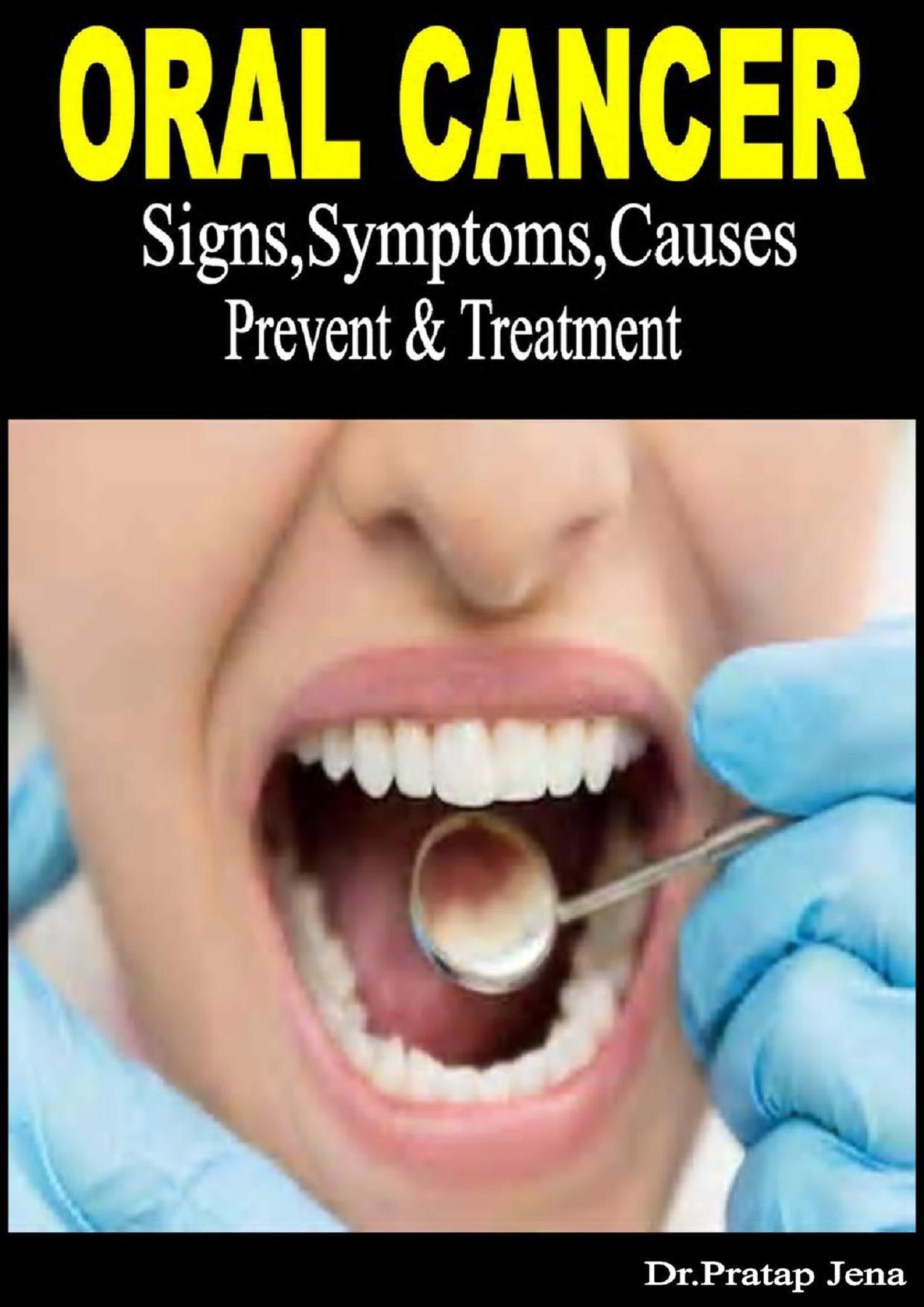
Oral Cancer Signs,Symptoms,Causes,Prevent and Treatment
On Sale
$3.00
$3.00
Oral cancer will be cancer that develops in the tissues of the mouth or throat. It has a place with a bigger gathering of cancers called head and neck cancers. The oral hole (mouth) and the upper piece of the throat (pharynx) have parts in numerous critical capacities, including breathing, talking, biting, and gulping. The mouth and upper throat are now and then alluded to as the oropharynx or oral hole. The critical structures of the mouth and upper throat incorporate the accompanying:
In excess of 49,000 instances of oral cancer are analyzed every year in the United States, happening most often in people more than 40 years old. Oral cancers are most often found after they've spread to the lymph hubs of the neck. Early detection is vital to surviving oral cancer. Learn about what raises your risk, its stages, and the sky is the limit from there. •Each year, just about 50,000 individuals in the U.S. will get oral depression or oropharyngeal cancer. Around 9,700 individuals will kick the bucket of these cancers.
Oral cancers incorporate cancers of the:
lips
tongue
inward covering of the cheek
gums
floor of the mouth
hard and soft palate
Your dentist is often the first healthcare supplier to notice indications of oral cancer. Getting half-yearly dental checkups can stay up with the latest on the health of your mouth.
Risk factors for developing oral cancer
This incorporates smoking cigarettes, stogies, and funnels, just as biting tobacco.
People who devour a lot of alcohol and tobacco are at a considerably greater risk, particularly when both products are used all the time.
Other risk factors include:
human papillomavirus (HPV) infection
chronic facial sun exposure
a past diagnosis of oral cancer
a family ancestry of oral or other types of cancer
a debilitated insusceptible system
poor nutrition
genetic syndromes
being male
Men are twice as liable to get oral cancer as women seem to be.
•Lips
•Inside covering of the cheeks (mucosa)
•Teeth
•Gums (gingiva)
•Tongue
•Floor of the mouth
•Back of the throat, including the tonsils (oropharynx)
•Roof of the mouth (the hard front part [hard palate] and the gentler back part [soft palate])
•Area behind the astuteness teeth
•Salivary organs
Various cell composes make up these distinctive structures. Cancer happens when typical cells experience a change whereby they develop and duplicate without ordinary controls. Harmful tumors (cancers) of the oral cavity can infringe on and attack neighbouring tissues. They can likewise spread to remote destinations in the body through the circulation system or to lymph hubs by means of the lymph vessels. The way toward attacking and spreading to different organs is called metastasis.
Tumors in the mouth (oral cancer) and throat (oropharyngeal cancer) incorporate both amiable (not cancer) and dangerous writes.
•Benign tumors, despite the fact that they may develop and infiltrate underneath the surface layer of tissue, don't spread by metastasis to different parts of the body. Favourable tumors of the oropharynx are not talked about in this article.
Premalignant conditions are cell changes that are not cancer but rather which may progress toward becoming cancer if not treated.
•Dysplasia is another name for this precancerous cell transforms It implies strange development.
•Dysplasia can be identified just by taking a biopsy of the sore.
•Examining the dysplastic cells under a magnifying lens demonstrates how extreme the progressions are and how likely the injury is to end up cancerous.
•The dysplastic changes are typically depicted as mellow, modestly serious, or extreme.
The two most basic sorts of premalignant injuries in the oropharynx are leukoplakia and erythroplakia.
•Leukoplakia is a white or whitish territory on the tongue or within the mouth. It can regularly be effortlessly scratched off without draining and creates in light of incessant (long haul) bothering. Just around 5% of leukoplakias are cancerous at conclusion or will end up cancerous inside 10 years if not treated.
•Erythroplakia is a raised, red region. In the event that scratched, it might drain. Erythroplakia is for the most part more extreme than leukoplakia and has a higher shot of getting to be cancerous after some time.
•Mixed white and red territories (erythroleukoplakia) can likewise happen and speak to premalignant injuries of the oral depression.
•These are frequently recognized by a dental practitioner at a standard dental examination.
A few sorts of dangerous cancers happen in the mouth and throat.
•Squamous cell carcinoma is by a long shot the most widely recognized write, representing over 90% all things considered. These cancers begin in the squamous cells, which frame the surface of a significant part of the covering of the mouth and pharynx. They can attack further layers beneath the squamous layer.
•Other less basic cancers of the Oral incorporate tumors of the minor salivary organs called adenocarcinomas and lymphoma.
•Cancers of the Oral don't generally metastasize, yet those that do normally spread initially to the lymph hubs of the neck. From that point, they may spread to more far off parts of the body.
•Cancers of the Oral happen in twice the same number of men as ladies.
•These cancers can create at any age however happen most as often as possible in individuals matured 45 years and more seasoned.
•Incidence rates of Oral cancers fluctuate generally from nation to nation. These varieties are because of contrasts in risk factor exposures.
In excess of 49,000 instances of oral cancer are analyzed every year in the United States, happening most often in people more than 40 years old. Oral cancers are most often found after they've spread to the lymph hubs of the neck. Early detection is vital to surviving oral cancer. Learn about what raises your risk, its stages, and the sky is the limit from there. •Each year, just about 50,000 individuals in the U.S. will get oral depression or oropharyngeal cancer. Around 9,700 individuals will kick the bucket of these cancers.
Oral cancers incorporate cancers of the:
lips
tongue
inward covering of the cheek
gums
floor of the mouth
hard and soft palate
Your dentist is often the first healthcare supplier to notice indications of oral cancer. Getting half-yearly dental checkups can stay up with the latest on the health of your mouth.
Risk factors for developing oral cancer
This incorporates smoking cigarettes, stogies, and funnels, just as biting tobacco.
People who devour a lot of alcohol and tobacco are at a considerably greater risk, particularly when both products are used all the time.
Other risk factors include:
human papillomavirus (HPV) infection
chronic facial sun exposure
a past diagnosis of oral cancer
a family ancestry of oral or other types of cancer
a debilitated insusceptible system
poor nutrition
genetic syndromes
being male
Men are twice as liable to get oral cancer as women seem to be.
•Lips
•Inside covering of the cheeks (mucosa)
•Teeth
•Gums (gingiva)
•Tongue
•Floor of the mouth
•Back of the throat, including the tonsils (oropharynx)
•Roof of the mouth (the hard front part [hard palate] and the gentler back part [soft palate])
•Area behind the astuteness teeth
•Salivary organs
Various cell composes make up these distinctive structures. Cancer happens when typical cells experience a change whereby they develop and duplicate without ordinary controls. Harmful tumors (cancers) of the oral cavity can infringe on and attack neighbouring tissues. They can likewise spread to remote destinations in the body through the circulation system or to lymph hubs by means of the lymph vessels. The way toward attacking and spreading to different organs is called metastasis.
Tumors in the mouth (oral cancer) and throat (oropharyngeal cancer) incorporate both amiable (not cancer) and dangerous writes.
•Benign tumors, despite the fact that they may develop and infiltrate underneath the surface layer of tissue, don't spread by metastasis to different parts of the body. Favourable tumors of the oropharynx are not talked about in this article.
Premalignant conditions are cell changes that are not cancer but rather which may progress toward becoming cancer if not treated.
•Dysplasia is another name for this precancerous cell transforms It implies strange development.
•Dysplasia can be identified just by taking a biopsy of the sore.
•Examining the dysplastic cells under a magnifying lens demonstrates how extreme the progressions are and how likely the injury is to end up cancerous.
•The dysplastic changes are typically depicted as mellow, modestly serious, or extreme.
The two most basic sorts of premalignant injuries in the oropharynx are leukoplakia and erythroplakia.
•Leukoplakia is a white or whitish territory on the tongue or within the mouth. It can regularly be effortlessly scratched off without draining and creates in light of incessant (long haul) bothering. Just around 5% of leukoplakias are cancerous at conclusion or will end up cancerous inside 10 years if not treated.
•Erythroplakia is a raised, red region. In the event that scratched, it might drain. Erythroplakia is for the most part more extreme than leukoplakia and has a higher shot of getting to be cancerous after some time.
•Mixed white and red territories (erythroleukoplakia) can likewise happen and speak to premalignant injuries of the oral depression.
•These are frequently recognized by a dental practitioner at a standard dental examination.
A few sorts of dangerous cancers happen in the mouth and throat.
•Squamous cell carcinoma is by a long shot the most widely recognized write, representing over 90% all things considered. These cancers begin in the squamous cells, which frame the surface of a significant part of the covering of the mouth and pharynx. They can attack further layers beneath the squamous layer.
•Other less basic cancers of the Oral incorporate tumors of the minor salivary organs called adenocarcinomas and lymphoma.
•Cancers of the Oral don't generally metastasize, yet those that do normally spread initially to the lymph hubs of the neck. From that point, they may spread to more far off parts of the body.
•Cancers of the Oral happen in twice the same number of men as ladies.
•These cancers can create at any age however happen most as often as possible in individuals matured 45 years and more seasoned.
•Incidence rates of Oral cancers fluctuate generally from nation to nation. These varieties are because of contrasts in risk factor exposures.

